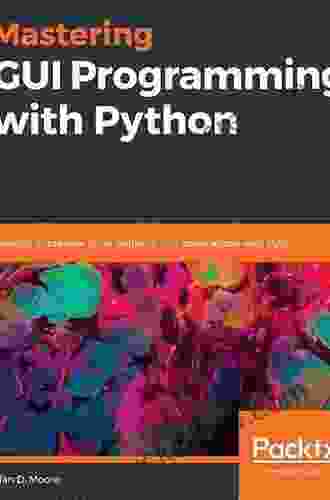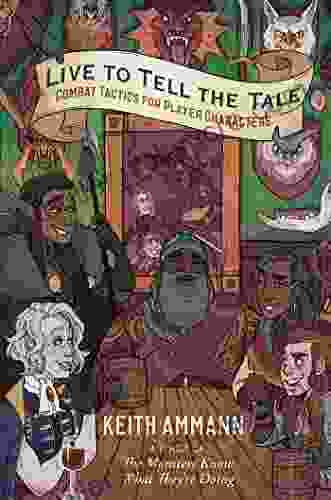Develop Impressive Cross Platform GUI Applications With PyQt

PyQt is a powerful Python library that allows developers to create cross-platform graphical user interfaces (GUIs) for desktop applications. It provides a comprehensive set of widgets, tools, and APIs that make it easy to build complex and user-friendly UIs for multiple platforms, including Windows, macOS, Linux, and embedded systems.
4.3 out of 5
| Language | : | English |
| Text-to-Speech | : | Enabled |
| Enhanced typesetting | : | Enabled |
| Print length | : | 1067 pages |
| File size | : | 4277 KB |
| Screen Reader | : | Supported |
In this comprehensive guide, we'll deep dive into the world of PyQt and explore its features, capabilities, and best practices for developing impressive cross-platform GUI applications. Whether you're a beginner or an experienced developer, this guide will provide you with all the necessary knowledge and insights to create stunning and engaging UIs for your applications.
Getting Started with PyQt
To get started with PyQt, you'll need to install it on your system. You can use pip, the Python package installer, to install PyQt using the following command:
pip install PyQt5
Once PyQt is installed, you can start creating your first GUI application. Here's a simple example of a PyQt application that displays a window with a button:
python import sys from PyQt5.QtWidgets import QApplication, QWidget, QPushButton
class Window(QWidget): def __init__(self): super().__init__()
self.initUI()
def initUI(self): self.setWindowTitle('PyQt Example') self.setGeometry(100, 100, 280, 170)
button = QPushButton('Click Me', self) button.setGeometry(100, 70, 80, 30) button.clicked.connect(self.on_click)
def on_click(self): print('Button clicked!')
if __name__ =='__main__': app = QApplication(sys.argv) window = Window() window.show() sys.exit(app.exec_())
When you run this code, it will create a simple window with a "Click Me" button. When you click the button, it will print "Button clicked!" in the console.
Exploring PyQt's Features and Capabilities
PyQt offers a wide range of features and capabilities that make it an ideal choice for developing cross-platform GUI applications. Here are some of the key features:
- Native Look and Feel: PyQt leverages the native UI elements of each platform, ensuring that your GUIs seamlessly integrate with the host operating system.
- Extensive Widget Library: PyQt provides a comprehensive library of widgets, including buttons, labels, menus, text boxes, and more, allowing you to create complex and feature-rich UIs.
- Cross-Platform Compatibility: PyQt supports multiple platforms, including Windows, macOS, Linux, and embedded systems, enabling you to reach a wider audience with your applications.
- Object-Oriented Design: PyQt follows the principles of object-oriented programming, making it easy to design, maintain, and extend your GUI applications.
- Event Handling: PyQt provides robust event handling mechanisms, allowing you to respond to user interactions, such as button clicks, mouse movements, and keyboard input.
- Database Connectivity: PyQt offers seamless integration with various database systems, enabling you to easily store and retrieve data from within your applications.
Best Practices for PyQt Development
To ensure the quality and efficiency of your PyQt applications, it's essential to follow some best practices:
- Use Qt Designer: Qt Designer is a visual design tool that allows you to create UIs visually, making it easier to prototype and design complex interfaces.
- Follow the MVC Pattern: The Model-View-Controller (MVC) pattern is a design pattern that separates the application's data model, presentation logic, and user interface, leading to increased maintainability and code organization.
- Use Qt Resources: Qt Resources allows you to bundle non-code resources, such as images, icons, and translations, into your applications, making it easier to manage and distribute assets.
- Test Your Applications: Writing automated tests for your PyQt applications ensures their stability and correctness, especially when targeting multiple platforms.
- Stay Updated with PyQt: PyQt is constantly evolving, with new features and improvements being added regularly. It's essential to stay updated with the latest PyQt versions to benefit from the latest enhancements.
Examples of PyQt Applications
PyQt has been used to develop a wide range of successful applications across various industries. Here are a few notable examples:
- VLC Media Player: VLC is a popular open-source media player that uses PyQt for its cross-platform GUI.
- Blender: Blender is a professional open-source 3D graphics creation suite that utilizes PyQt for its user interface.
- Maya: Maya is a 3D animation and modeling software that leverages PyQt for its graphical user interface.
- Inkscape: Inkscape is a free and open-source vector graphics editor that employs PyQt for its user interface.
- OpenStreetMap: OpenStreetMap is a collaborative project to create a free and open-source map of the world, with PyQt being used for its desktop GUI.
PyQt is an exceptional Python library that empowers developers to create stunning and user-friendly cross-platform GUI applications. Its comprehensive feature set, extensive widget library, and object-oriented design approach make it an ideal choice for building high-quality UIs. By following best practices, such as using Qt Designer, adhering to the MVC pattern, and staying updated with PyQt's latest advancements, you can develop robust and scalable GUI applications that meet the needs of your users across multiple platforms. With its proven track record in powering successful applications like VLC Media Player, Blender, and Maya, PyQt continues to be a trusted choice for GUI development in the Python community.
4.3 out of 5
| Language | : | English |
| Text-to-Speech | : | Enabled |
| Enhanced typesetting | : | Enabled |
| Print length | : | 1067 pages |
| File size | : | 4277 KB |
| Screen Reader | : | Supported |
Do you want to contribute by writing guest posts on this blog?
Please contact us and send us a resume of previous articles that you have written.
 Fiction
Fiction Non Fiction
Non Fiction Romance
Romance Mystery
Mystery Thriller
Thriller SciFi
SciFi Fantasy
Fantasy Horror
Horror Biography
Biography Selfhelp
Selfhelp Business
Business History
History Classics
Classics Poetry
Poetry Childrens
Childrens Young Adult
Young Adult Educational
Educational Cooking
Cooking Travel
Travel Lifestyle
Lifestyle Spirituality
Spirituality Health
Health Fitness
Fitness Technology
Technology Science
Science Arts
Arts Crafts
Crafts DIY
DIY Gardening
Gardening Petcare
Petcare Ryan M Cleckner
Ryan M Cleckner Brett Hull
Brett Hull Steven Hugg
Steven Hugg Michael Omi
Michael Omi Carol Dawson
Carol Dawson Phil Williams
Phil Williams Elsevier
Elsevier Jeremy J Baumberg
Jeremy J Baumberg Nadim Saad
Nadim Saad Kenneth Paul Rosenberg
Kenneth Paul Rosenberg Christopher Ketcham
Christopher Ketcham Peter Wacht
Peter Wacht Jd Tanner
Jd Tanner Ernle Bradford
Ernle Bradford Rob Coppolillo
Rob Coppolillo Kusha Karvandi
Kusha Karvandi Richard Hingley
Richard Hingley James A Whittaker
James A Whittaker Joe Grant
Joe Grant Brian Noyes
Brian Noyes Rosalyn Sheehy
Rosalyn Sheehy Brett Cohen
Brett Cohen Emil Frlez
Emil Frlez Dr Nanhee Byrnes
Dr Nanhee Byrnes Tom Cunliffe
Tom Cunliffe Nibedit Dey
Nibedit Dey Charles Wilson
Charles Wilson Cassandra Overby
Cassandra Overby Harold Gatty
Harold Gatty Sara Gaviria
Sara Gaviria Alex Horne
Alex Horne Rachel Love Nuwer
Rachel Love Nuwer Jacques Vallee
Jacques Vallee Hiram Bingham
Hiram Bingham Steven Shapin
Steven Shapin Oded Galor
Oded Galor Brion Toss
Brion Toss Dusan Petkovic
Dusan Petkovic Karen Wilkinson
Karen Wilkinson Steve Guest
Steve Guest Dr Monique Thompson Dha Lpc
Dr Monique Thompson Dha Lpc Renee Jain
Renee Jain Megan Whalen Turner
Megan Whalen Turner Ilchi Lee
Ilchi Lee Thomas Malory
Thomas Malory Gerson S Sher
Gerson S Sher Pastor Ahyh
Pastor Ahyh Stuart Woods
Stuart Woods Mark Lazerus
Mark Lazerus Samuel Arbesman
Samuel Arbesman Nicole Morales Lm Cpm
Nicole Morales Lm Cpm Cal Ripken
Cal Ripken David Wootton
David Wootton Lucia Guglielminetti
Lucia Guglielminetti Khalid Khashoggi
Khalid Khashoggi Jessica Minahan
Jessica Minahan Neil S Jacobson
Neil S Jacobson Miguel Crespo
Miguel Crespo Guy P Harrison
Guy P Harrison Vincent W Davis
Vincent W Davis Megan Kelley Hall
Megan Kelley Hall Joan Nathan
Joan Nathan Michel Odent
Michel Odent Lisa Leake
Lisa Leake Colleen Craig
Colleen Craig Steve Oakes
Steve Oakes John Major Jenkins
John Major Jenkins Doug Peacock
Doug Peacock Joanna Philbin
Joanna Philbin Terence Tao
Terence Tao Dan Washburn
Dan Washburn Jemar Tisby
Jemar Tisby Heyward Coleman
Heyward Coleman Cal Pater
Cal Pater Paula Span
Paula Span Chukwuma Eleodimuo
Chukwuma Eleodimuo John Connelly
John Connelly Mark Seemann
Mark Seemann Ron Lieber
Ron Lieber John Moren
John Moren Mohammad F Anwar
Mohammad F Anwar Lindsey Schlessinger
Lindsey Schlessinger Mike Eastman
Mike Eastman Rory D Nelson
Rory D Nelson Jhenah Telyndru
Jhenah Telyndru Matthew Desmond
Matthew Desmond Shannon Warden
Shannon Warden Garrett Redfield
Garrett Redfield Esther Hicks
Esther Hicks Malcolm Hebron
Malcolm Hebron Dava Sobel
Dava Sobel David Schoem
David Schoem Loyd Ellis
Loyd Ellis Eric R Dodge
Eric R Dodge Grace Friedman
Grace Friedman Einat L K
Einat L K Jonti Marks
Jonti Marks Brett Stewart
Brett Stewart E L Konigsburg
E L Konigsburg Eduardo Montano
Eduardo Montano Damien Cox
Damien Cox Kelle James
Kelle James F Brent Neal
F Brent Neal Lukas M Verburgt
Lukas M Verburgt Roman Gurbanov
Roman Gurbanov David Hatcher Childress
David Hatcher Childress Erin Mckittrick
Erin Mckittrick Penny Alexander
Penny Alexander John Wesson
John Wesson Sara Elliott Price
Sara Elliott Price Celina Grace
Celina Grace Jacqueline Houtman
Jacqueline Houtman Nathan Halberstadt
Nathan Halberstadt Christopher Clarey
Christopher Clarey John Jeffries Martin
John Jeffries Martin Tim Falconer
Tim Falconer Loan Le
Loan Le Derick Lugo
Derick Lugo Inger Mewburn
Inger Mewburn Mark J Ferrari
Mark J Ferrari Inge Bell
Inge Bell Maggie Dallen
Maggie Dallen Salima Ikram
Salima Ikram Maria Sharapova
Maria Sharapova Kevin Alexander
Kevin Alexander Jimmie Holland
Jimmie Holland Ann Imig
Ann Imig T D Wilson
T D Wilson Scott Hawthorn
Scott Hawthorn Paula Brackston
Paula Brackston Brian R King
Brian R King Xavier Wells
Xavier Wells Elwyn Hartley Edwards
Elwyn Hartley Edwards Rahul Jandial
Rahul Jandial Warren Hansen
Warren Hansen Jonathan H Turner
Jonathan H Turner Lucas Chancel
Lucas Chancel Lewis Black
Lewis Black Robin Dunbar
Robin Dunbar John D Couch
John D Couch Wil Fleming
Wil Fleming Seb Falk
Seb Falk Robert Wright
Robert Wright Brogan Steele
Brogan Steele Kerry Mcdonald
Kerry Mcdonald Don L Gates
Don L Gates Jean Nayar
Jean Nayar Steve Wiegand
Steve Wiegand James Floyd Kelly
James Floyd Kelly Jane Albert
Jane Albert Joanna Sayago Golub
Joanna Sayago Golub Richard Blais
Richard Blais F R Lifestyle
F R Lifestyle Jason Brick
Jason Brick Steve Williams
Steve Williams Marguerite Henry
Marguerite Henry Brian Reddington
Brian Reddington John A Fortunato
John A Fortunato Brian Gewirtz
Brian Gewirtz Charles Todd
Charles Todd Jacob Boehme
Jacob Boehme Nicholas Gallo
Nicholas Gallo Bonnie Henderson
Bonnie Henderson Peggy Kaye
Peggy Kaye Lisa Druxman
Lisa Druxman Ji Kim
Ji Kim Roshani Chokshi
Roshani Chokshi Ursula Hackett
Ursula Hackett Clayton King
Clayton King Thao Te
Thao Te O S Hawkins
O S Hawkins David Jason
David Jason Varg Freeborn
Varg Freeborn Steven Cross
Steven Cross Michael A Tompkins
Michael A Tompkins Melinda Tankard Reist
Melinda Tankard Reist Kent Hoffman
Kent Hoffman Jeanne Flavin
Jeanne Flavin Smart Edition
Smart Edition 1st Ed 2018 Edition Kindle Edition
1st Ed 2018 Edition Kindle Edition Bruce A Fenderson
Bruce A Fenderson Sarah Lamb
Sarah Lamb Matt Schifferle
Matt Schifferle Kaylene Yoder
Kaylene Yoder Catherine Shainberg
Catherine Shainberg Richard A Jaffe
Richard A Jaffe Kathleen Taylor
Kathleen Taylor Rick Steves
Rick Steves Mike Adams
Mike Adams Elizabeth Dupart
Elizabeth Dupart Sandra M Nettina
Sandra M Nettina Paul Farmer
Paul Farmer Steven W Vannoy
Steven W Vannoy S Connolly
S Connolly Joanne M Flood
Joanne M Flood James M Jones
James M Jones Cindy Margolis
Cindy Margolis Rich Osthoff
Rich Osthoff Dan Fullerton
Dan Fullerton Charlie Francis
Charlie Francis Vicki Franz
Vicki Franz Karl F Kuhn
Karl F Kuhn John Bradshaw
John Bradshaw Stephen Wood
Stephen Wood Maurice Herzog
Maurice Herzog Luis Preto
Luis Preto Daniel Bagur
Daniel Bagur Jodi Aman
Jodi Aman Michael Mason
Michael Mason Judith A Owens
Judith A Owens Jeanne Ellis Ormrod
Jeanne Ellis Ormrod Matt Davids
Matt Davids Patrick Garbin
Patrick Garbin Keith Foskett
Keith Foskett Worth Books
Worth Books Patrick Carnes
Patrick Carnes Meg Cabot
Meg Cabot Patti Henry
Patti Henry Piero Ferrucci
Piero Ferrucci James Miller
James Miller Harry Vardon
Harry Vardon Martin Sternstein
Martin Sternstein David Murray
David Murray Sam Sorbo
Sam Sorbo James D Tabor
James D Tabor Grace Mccready
Grace Mccready Jeannette De Wyze
Jeannette De Wyze Larry A Yff
Larry A Yff Kate Mcmillan
Kate Mcmillan Grete Waitz
Grete Waitz Kathleen Cushman
Kathleen Cushman Curtis Wilkie
Curtis Wilkie George Case
George Case Keith Ammann
Keith Ammann Daniel Bergner
Daniel Bergner Cheryl Diamond
Cheryl Diamond Douglas Wood
Douglas Wood Nick Heil
Nick Heil Natalia Ilyin
Natalia Ilyin Jameswesley Rawles
Jameswesley Rawles Joanna Faber
Joanna Faber Gene Kritsky
Gene Kritsky John Monaghan
John Monaghan Soong Chan Rah
Soong Chan Rah Richard Bass
Richard Bass Colleen Doyle Bryant
Colleen Doyle Bryant Dave Cutcher
Dave Cutcher Keith Ryan Cartwright
Keith Ryan Cartwright Samantha Michaels
Samantha Michaels John Fraser Hart
John Fraser Hart Ted Franklin Belue
Ted Franklin Belue Elizabeth Davis
Elizabeth Davis Pat Manocchia
Pat Manocchia Bret Stetka
Bret Stetka Gerald L Schroeder
Gerald L Schroeder Derek Blasberg
Derek Blasberg Scott Reed
Scott Reed Nachole Johnson
Nachole Johnson David M Ewalt
David M Ewalt Scott Zimmerman
Scott Zimmerman Karen Ward Mahar
Karen Ward Mahar Molly Caldwell Crosby
Molly Caldwell Crosby Steven Trustrum
Steven Trustrum Eric Michael
Eric Michael Mary Morrison
Mary Morrison Michael Shaw
Michael Shaw Tyler Hamilton
Tyler Hamilton Grace Mariana Rector
Grace Mariana Rector Eze Ugbor
Eze Ugbor Zigzag English
Zigzag English Frederick L Coolidge
Frederick L Coolidge Michael Sullivan Iii
Michael Sullivan Iii Kevin Marx
Kevin Marx Joyce Bas
Joyce Bas Genie Reads
Genie Reads Douglas R Hofstadter
Douglas R Hofstadter George Olsen
George Olsen Christine Brennan
Christine Brennan Jp Kriya
Jp Kriya Marc Bona
Marc Bona Susan F Paterno
Susan F Paterno Gerald R Allen
Gerald R Allen Jennifer Comeaux
Jennifer Comeaux Wilborn Hampton
Wilborn Hampton Karen E Mcconnell
Karen E Mcconnell Nora Roberts
Nora Roberts D Levesque
D Levesque Sarah Kleck
Sarah Kleck Edith Hall
Edith Hall Geoffrey Simpson
Geoffrey Simpson Nate Allen
Nate Allen Patty Wipfler
Patty Wipfler Gjoko Muratovski
Gjoko Muratovski Peter Allison
Peter Allison Porter Shimer
Porter Shimer William Albert Robinson
William Albert Robinson David Cannon
David Cannon Guido W Imbens
Guido W Imbens Tobe Melora Correal
Tobe Melora Correal Debra Fine
Debra Fine Gabriel F Federico
Gabriel F Federico Htebooks
Htebooks Nicholas S Howe
Nicholas S Howe Stephanie Perkins
Stephanie Perkins St Teresa Of Avila
St Teresa Of Avila Megan Davidson
Megan Davidson Dinesh Kumar Goyal
Dinesh Kumar Goyal Dr Alison Dibarto Goggin
Dr Alison Dibarto Goggin Howtodressage
Howtodressage Jackie Freeman
Jackie Freeman Mick Conefrey
Mick Conefrey Mary Strand
Mary Strand J F James
J F James James Kaiser
James Kaiser Mark Johnston
Mark Johnston Peter Zuckerman
Peter Zuckerman Bruce Lee
Bruce Lee Jeannie Burlowski
Jeannie Burlowski J C Cervantes
J C Cervantes Lee Alan Dugatkin
Lee Alan Dugatkin Tadashi Yoshimura
Tadashi Yoshimura Lana Peek
Lana Peek Ethan Bezos
Ethan Bezos Jason Sandy
Jason Sandy Kyle Rohrig
Kyle Rohrig Calvin Trillin
Calvin Trillin David Flanagan
David Flanagan Pittacus Lore
Pittacus Lore Steven Verrier
Steven Verrier Paul Simpson
Paul Simpson Courtney Macavinta
Courtney Macavinta Lori Lyons
Lori Lyons Sandy Jones
Sandy Jones Jay Asher
Jay Asher Rachel Mcgrath
Rachel Mcgrath Brian Everitt
Brian Everitt Dr Faith G Harper
Dr Faith G Harper Gustav Meyrink
Gustav Meyrink Bruce Macdonald
Bruce Macdonald Lisa Scottoline
Lisa Scottoline G E R Lloyd
G E R Lloyd Natalia Rojas
Natalia Rojas Genevieve Bardwell
Genevieve Bardwell Martin Odersky
Martin Odersky Laura A Jana
Laura A Jana Helen Zee
Helen Zee P A Johnson
P A Johnson Martin A Lee
Martin A Lee Jp Lepeley
Jp Lepeley Christy Teglo
Christy Teglo Collins O Onwe
Collins O Onwe Bryan Berard
Bryan Berard Sunil Tanna
Sunil Tanna Breanna Hayse
Breanna Hayse Mahmood Mamdani
Mahmood Mamdani Adrienne Onofri
Adrienne Onofri Arthur Scott Bailey
Arthur Scott Bailey Michael Sean Comerford
Michael Sean Comerford Scott Jurek
Scott Jurek Joseph Burbridge
Joseph Burbridge Adam Night
Adam Night Chuanwei Li
Chuanwei Li Brian Herne
Brian Herne Jim White
Jim White Claudia M Gold
Claudia M Gold Laurie A Watkins
Laurie A Watkins Megan Smolenyak
Megan Smolenyak Brittany Cavallaro
Brittany Cavallaro John Mcenroe
John Mcenroe Nicholas Bjorn
Nicholas Bjorn Melanie Challenger
Melanie Challenger Julie Cangialosi
Julie Cangialosi Carlo Zen
Carlo Zen Matt Parker
Matt Parker Colette Harris
Colette Harris Sonja Schwartzbach
Sonja Schwartzbach Lucinda Scala Quinn
Lucinda Scala Quinn Nancy Boyd Franklin
Nancy Boyd Franklin Deborah Shouse
Deborah Shouse Lee Mcintyre
Lee Mcintyre Luis Angel Echeverria
Luis Angel Echeverria Brienne Murk
Brienne Murk Mitchel P Roth
Mitchel P Roth Diana J Mason
Diana J Mason Marc J Reilly
Marc J Reilly Avery Faigenbaum
Avery Faigenbaum Lucy Hopping
Lucy Hopping Manfred Theisen
Manfred Theisen Phyllis Books
Phyllis Books Stephanie Sarkis
Stephanie Sarkis Mark Powell
Mark Powell Kate S Martin
Kate S Martin Fritjof Capra
Fritjof Capra Timothy A Sisemore
Timothy A Sisemore David Hoffman
David Hoffman David Levithan
David Levithan Ksenia K
Ksenia K Emilee Day
Emilee Day David Sinclair
David Sinclair Sean Michael Wilson
Sean Michael Wilson Rob Collins
Rob Collins Daniel Dell Uomo
Daniel Dell Uomo Peggy Tharpe
Peggy Tharpe Jaime Flowers
Jaime Flowers Steve Bromley
Steve Bromley Ivan Savov
Ivan Savov Jennifer Block
Jennifer Block Emily Lauren Dick
Emily Lauren Dick David Hackett Fischer
David Hackett Fischer William Shakespeare
William Shakespeare David Mcclung
David Mcclung T J Tomasi
T J Tomasi Victor A Bloomfield
Victor A Bloomfield Cpt Exam Prep Team
Cpt Exam Prep Team Matt Wastradowski
Matt Wastradowski Rick J Scavetta
Rick J Scavetta Caitlin Flanagan
Caitlin Flanagan Thomas A Jacobs
Thomas A Jacobs Rob Vollman
Rob Vollman Mitt Romney
Mitt Romney Janae M Robinson
Janae M Robinson Chase Hassen
Chase Hassen Pedro Sarmiento De Gamboa
Pedro Sarmiento De Gamboa Kindle Edition
Kindle Edition Jackson T Markbrown
Jackson T Markbrown Henry Worsley
Henry Worsley Denise Long
Denise Long Matt Doeden
Matt Doeden Carol Newell
Carol Newell Jeremy Bradstreet
Jeremy Bradstreet Roach Mary
Roach Mary Cecilia Twinch
Cecilia Twinch Brooks Blevins
Brooks Blevins Florence Weiser
Florence Weiser Kazumi Tabata
Kazumi Tabata Richard Post
Richard Post M A Hayat
M A Hayat Martin Wells
Martin Wells William Trubridge
William Trubridge Ned Mcintosh
Ned Mcintosh Kicki Hansard
Kicki Hansard E G Richards
E G Richards Della Ata Khoury
Della Ata Khoury Harry Bauld
Harry Bauld Brian Kilmeade
Brian Kilmeade Danny Staple
Danny Staple Heather Rose
Heather Rose Kara Forney
Kara Forney Nehemia Gordon
Nehemia Gordon Mark Howard
Mark Howard Caitlyn Dare
Caitlyn Dare Rich Cohen
Rich Cohen James O Prochaska
James O Prochaska Krishna Godhania
Krishna Godhania Jules Wake
Jules Wake Masaaki Kijima
Masaaki Kijima Deepak Chopra
Deepak Chopra Patricia Wooster
Patricia Wooster Dan Jones
Dan Jones Paul Carus
Paul Carus J R Mathews
J R Mathews Jonathan Grix
Jonathan Grix Matt Morton
Matt Morton Michael Barkun
Michael Barkun Janice L Raymond
Janice L Raymond Steven Emanuel
Steven Emanuel Kira Breed Wrisley
Kira Breed Wrisley William Souder
William Souder Dr Lena Edwards
Dr Lena Edwards Sriman Sharma
Sriman Sharma Frederick Grinnell
Frederick Grinnell Robert Ullman
Robert Ullman Steve Schwartz
Steve Schwartz Dave Ramsey
Dave Ramsey Scott Haines
Scott Haines Shayla Black
Shayla Black Hal R Varian
Hal R Varian Eric C Lindstrom
Eric C Lindstrom Toni Weschler
Toni Weschler Juliet Miller
Juliet Miller Bernard Darwin
Bernard Darwin Dawna Markova
Dawna Markova Richard Kasper
Richard Kasper Mary Heffernan
Mary Heffernan James Zug
James Zug Milne Cc Pocock
Milne Cc Pocock Neil Postman
Neil Postman David Barrett
David Barrett Clyde Soles
Clyde Soles Melissa Trevathan
Melissa Trevathan Brian W Kernighan
Brian W Kernighan Tim Dunn
Tim Dunn Samuel Greenberg
Samuel Greenberg Alan D Moore
Alan D Moore Jay H Lefkowitch
Jay H Lefkowitch Michael Masters
Michael Masters J R Harris
J R Harris J Wayne Fears
J Wayne Fears Ian Tuhovsky
Ian Tuhovsky Ronald M Rapee
Ronald M Rapee Cecelia Ahern
Cecelia Ahern Carol Walters
Carol Walters D Enette Larson Meyer
D Enette Larson Meyer Joseph Ewing
Joseph Ewing Tom M Apostol
Tom M Apostol Michael Ruhlman
Michael Ruhlman Judy H Wright
Judy H Wright John M Taylor
John M Taylor Santari Green
Santari Green James Dean
James Dean Mike Weatherstone
Mike Weatherstone Joel Ingersoll
Joel Ingersoll Lenore Skenazy
Lenore Skenazy Murray Shukyn
Murray Shukyn Kalynn Bayron
Kalynn Bayron Leslie Valiant
Leslie Valiant Colleen Houck
Colleen Houck Marco Polo
Marco Polo Daniel Vaughan
Daniel Vaughan Leigh Pearson
Leigh Pearson Lily Raff Mccaulou
Lily Raff Mccaulou Iwan Rhys Morus
Iwan Rhys Morus Estelle Dautry
Estelle Dautry Michael O Emerson
Michael O Emerson Elliot Davis
Elliot Davis Mariana Monteiro
Mariana Monteiro Joyce Harper
Joyce Harper Phillip Stephen Schulz
Phillip Stephen Schulz Paul Weamer
Paul Weamer Don Brown
Don Brown David Barrie
David Barrie D S Malik
D S Malik Chuck Callaway
Chuck Callaway Jez Cajiao
Jez Cajiao Mark William
Mark William Bobbi Conner
Bobbi Conner Sujit Sivasundaram
Sujit Sivasundaram Carol Kaesuk Yoon
Carol Kaesuk Yoon Trish Kuffner
Trish Kuffner John Cooper
John Cooper John Mclachlan
John Mclachlan Claudia Gray
Claudia Gray Sue Wieger
Sue Wieger Kathleen Bartholomew
Kathleen Bartholomew Diane Ravitch
Diane Ravitch Linda Carter
Linda Carter Stephen Hawking
Stephen Hawking
Light bulbAdvertise smarter! Our strategic ad space ensures maximum exposure. Reserve your spot today!

 Hassan CoxThe Right Way to Play Chess: A Comprehensive Guide for Beginners and Advanced...
Hassan CoxThe Right Way to Play Chess: A Comprehensive Guide for Beginners and Advanced...
 Harvey BellThe Deep Water and Shoals of William Albert Robinson: Exploring the Literary...
Harvey BellThe Deep Water and Shoals of William Albert Robinson: Exploring the Literary... Glenn HayesFollow ·11k
Glenn HayesFollow ·11k Charlie ScottFollow ·15.3k
Charlie ScottFollow ·15.3k Galen PowellFollow ·13.2k
Galen PowellFollow ·13.2k Harold BlairFollow ·11.1k
Harold BlairFollow ·11.1k Tennessee WilliamsFollow ·5.9k
Tennessee WilliamsFollow ·5.9k Clarence MitchellFollow ·3.3k
Clarence MitchellFollow ·3.3k Frank ButlerFollow ·17.7k
Frank ButlerFollow ·17.7k Mario Vargas LlosaFollow ·7.1k
Mario Vargas LlosaFollow ·7.1k

 Guillermo Blair
Guillermo Blair2nd Edition Revised And Expanded 2024: A Comprehensive...
The 2nd Edition Revised...

 Ronald Simmons
Ronald SimmonsDreaming of Ocean Cruising: A Voyage into Tranquility and...
For those seeking a respite from the mundane...

 Darren Nelson
Darren Nelson100 Nursing Practice Questions with Rationales to...
The NCLEX exam is a challenging but...

 Rex Hayes
Rex HayesMastering Bodyweight Training for Martial Arts: A...
For martial...

 Dillon Hayes
Dillon HayesIn The Land Of The Blue Poppies: A Literary Journey to...
Prologue: A Tapestry of...

 Eliot Foster
Eliot FosterCollege University Writing Super Review Flash Card Books:...
College University...
4.3 out of 5
| Language | : | English |
| Text-to-Speech | : | Enabled |
| Enhanced typesetting | : | Enabled |
| Print length | : | 1067 pages |
| File size | : | 4277 KB |
| Screen Reader | : | Supported |








